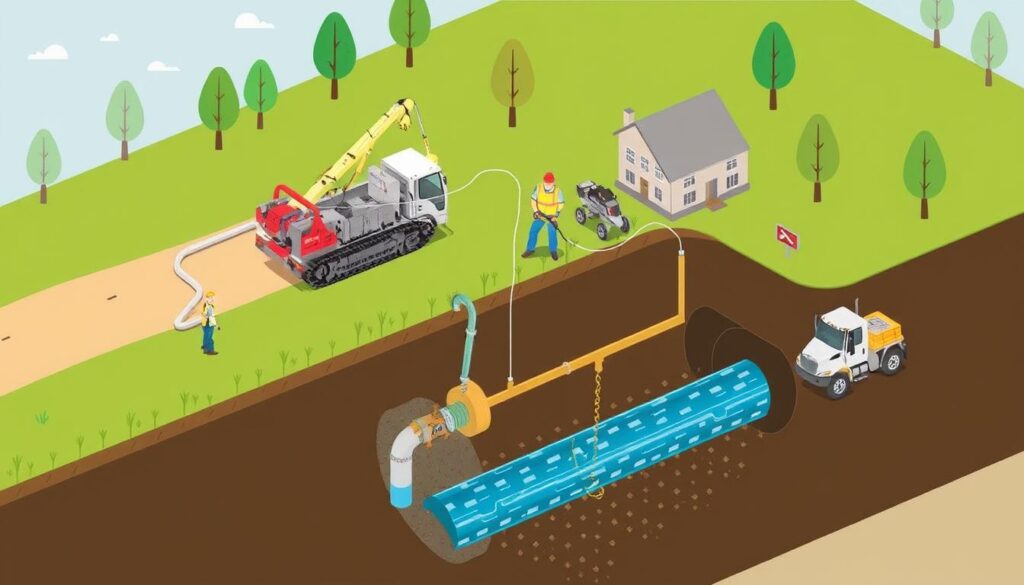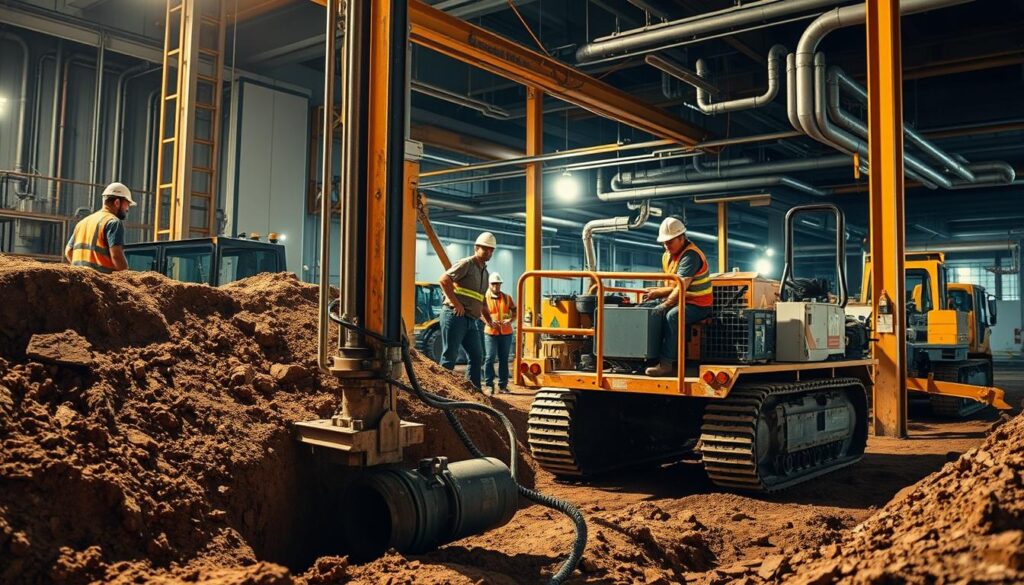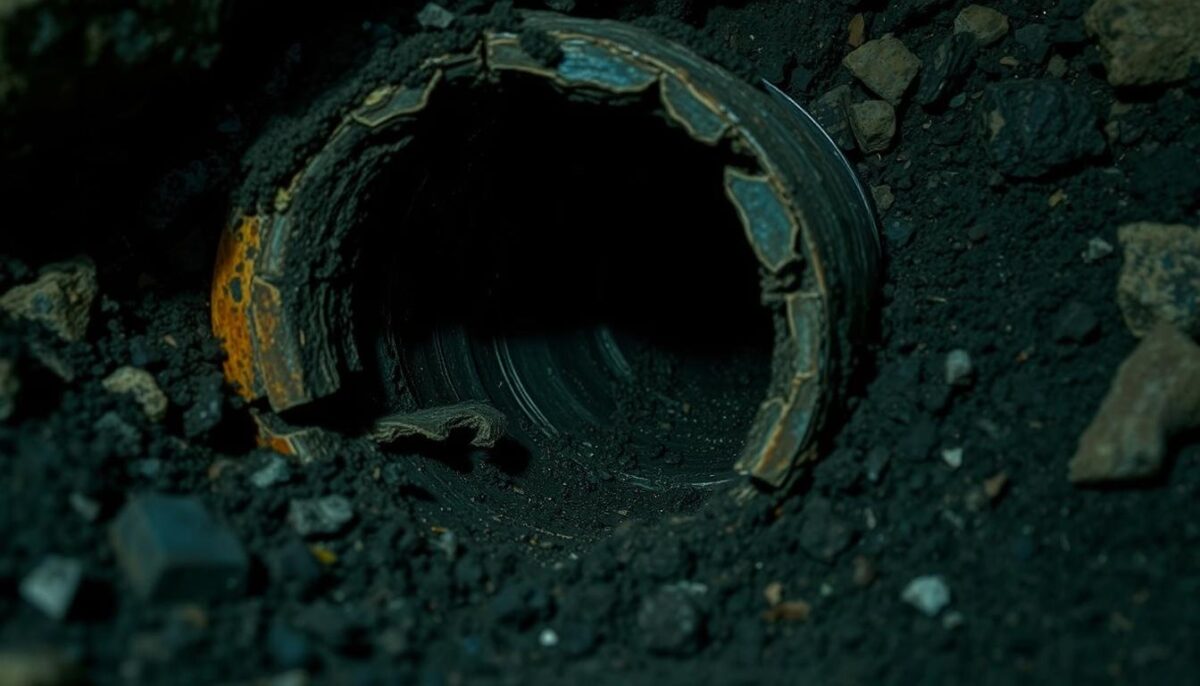What Is Trenchless Sewer Repair and Is It Worth It?
A problem with your sewer line is a serious matter that requires immediate attention. Ignoring sewer problems or attempting to fix them yourself can lead to costly and hazardous sewage backups that may affect not just your home, but others on your block as well.
Traditionally, plumbers would have to dig up your yard to access and repair the pipe. However, trenchless sewer line repair allows technicians to access your sewer line with minimal impact on your lawn and landscaping.
This modern plumbing solution involves using specialized technology to diagnose and fix issues without extensive digging.
Key Takeaways
- Understand the technology behind trenchless sewer repairs and its benefits.
- Learn how to identify common signs of sewer line problems.
- Discover the different trenchless repair methods available.
- Compare trenchless and traditional repair methods.
- Determine if trenchless sewer repair is worth the investment for your home.
Understanding Sewer Line Problems
Understanding the intricacies of sewer line issues is crucial for homeowners to prevent potential disasters. Even well-built sewer lines manufactured from high-quality materials will eventually wear out due to the harsh operating conditions they endure daily.
Sewer lines are tasked with containing and transporting all types of wastewater, waste material, and debris out to the sewer system. Over time, these lines can crack, leak, and spill sewage onto your property, a problem more common in older homes but possible in any home.
Common Sewer Line Issues
Sewer line issues can arise from various factors, including aging pipes, tree root intrusion, and ground shifts. These issues can lead to a range of problems, from slow draining fixtures to complete backups.
The condition of your line can be compromised by external factors such as soil movement and internal factors like corrosion.
Signs You Need Sewer Line Repair
Several signs indicate you need sewer line repair. These include:
- Multiple drains backing up simultaneously, suggesting a main line blockage.
- Foul odors from drains or your yard, indicating sewage leaks.
- Lush, green patches in your lawn, possibly due to underground sewage leaks.
- Slow draining fixtures, even after clearing attempts, pointing to a deeper issue.
- Unusual sounds like gurgling toilets or drains, signaling air trapped due to blockages.
Recognizing these signs early can help prevent a minor problem from becoming a major damage.
What Is Trenchless Sewer Repair?
When it comes to fixing damaged sewer lines, trenchless sewer repair has emerged as a highly effective and efficient method. This innovative technique allows for the repair or replacement of sewer lines with minimal excavation, reducing the disruption to your property.

How Trenchless Technology Works
Trenchless sewer repair involves using advanced technology to fix damaged sewer pipes without the need for extensive digging. This method is ideal for pipes that are structurally intact but suffering from issues like cracks, leaks, or root intrusion.
The technology used in trenchless sewer repair includes methods like pipe lining and pipe bursting. Pipe lining involves inserting a new liner into the existing pipe, which is then cured to create a new, durable pipe within the old one. Pipe bursting, on the other hand, involves breaking the old pipe and replacing it with a new one.
When Trenchless Repair Is Possible
Trenchless repair is not always possible, as its feasibility depends on the condition of the sewer line. It is ideal for pipes that are still relatively round and not completely collapsed. The condition of your sewer line must be thoroughly assessed through a camera inspection before determining if trenchless repair is viable.
Some key points to consider for trenchless repair viability include:
- Trenchless repair is ideal for pipes that are structurally intact but suffering from cracks, leaks, or root intrusion that haven’t completely compromised the pipe’s integrity.
- This method works best when the existing pipe is still relatively round and not completely collapsed, allowing the new liner or replacement pipe to be properly installed.
- Pipes made of various materials including clay, cast iron, PVC, and concrete can typically be repaired using trenchless methods, making it versatile for different home ages.
- The condition of your sewer line must be thoroughly assessed through camera inspection before determining if trenchless repair is viable for your specific situation.
- Trenchless repair may not be possible if your pipe has severe structural issues like complete collapse, major misalignment, or extensive bellying (sagging) that affects proper flow.
Trenchless Sewer Repair Methods

The advancement in trenchless technology has led to the development of multiple methods for sewer line repair and replacement. These methods offer homeowners and property managers efficient and less invasive solutions to sewer line issues.
Trenchless sewer repair methods are designed to minimize disruption to daily activities and reduce the aesthetic impact of traditional excavation methods. Two of the most common trenchless sewer repair techniques are pipe lining and pipe bursting.
Pipe Lining (CIPP) Method
Pipe lining, also known as Cured-In-Place Pipe (CIPP) lining, is a popular trenchless method for repairing damaged sewer lines. This technique involves inserting a resin-coated liner into the damaged pipe, which is then cured to form a new, durable pipe within the existing one.
The Process
The pipe lining process begins with a thorough inspection of the sewer line to identify the extent of the damage. The pipe is then cleaned to remove any debris or obstructions. A resin-coated liner is inserted into the pipe through an access point, and the liner is inflated to fit snugly against the interior of the existing pipe. The resin is then cured, typically using hot water or steam, to create a new, structurally sound pipe.
Best Applications
Pipe lining is ideal for repairing leaks, cracks, and minor collapses in sewer lines. It is particularly effective for pipes with multiple small defects, as it can seal the entire length of the pipe. This method is also beneficial for pipes that are difficult to access or in locations where excavation would be costly or disruptive.
Pipe Bursting Method
Pipe bursting is another effective trenchless method used for sewer line repair and replacement. This technique involves breaking the existing damaged pipe while simultaneously pulling a new pipe into place.
The Process
The pipe bursting process starts with the insertion of a bursting head into the damaged pipe. The bursting head is pulled through the pipe, breaking it apart and creating a cavity for the new pipe. As the bursting head moves through the pipe, it pulls the new pipe behind it, effectively replacing the old pipe with a new one.
Best Applications
Pipe bursting is ideal for completely replacing severely damaged, collapsed, or deteriorated sewer lines that are beyond repair with lining methods. It is also suitable for increasing the pipe diameter to improve flow capacity, such as when adding new fixtures or bathrooms to a property.
| Method | Ideal Applications | Key Benefits |
|---|---|---|
| Pipe Lining (CIPP) | Repairing leaks, cracks, and minor collapses; suitable for pipes with multiple small defects. | Minimally invasive; seals entire pipe length; reduces future repair needs. |
| Pipe Bursting | Replacing severely damaged or collapsed pipes; increasing pipe diameter for improved flow. | Allows for pipe diameter increase; suitable for pipes with significant damage; reduces need for future repairs. |
Trenchless vs. Traditional Sewer Repair
The choice between trenchless sewer repair and traditional excavation is significant for property owners dealing with sewer line issues. Both methods have their advantages and disadvantages, which are crucial to understand to make an informed decision.
Pros of Trenchless Repair
Trenchless sewer repair offers several benefits, including minimal disruption to property and landscaping. Unlike traditional excavation, trenchless methods require less digging, which means less damage to your yard and fewer restoration costs after the repair.
- Reduced excavation time
- Less impact on daily activities
- Lower restoration costs for landscaping
Additionally, trenchless repair is often faster than traditional methods because it eliminates the need for extensive digging. This can be particularly advantageous for properties with complex landscaping or those in densely populated areas.
Cons of Trenchless Repair
Despite its advantages, trenchless sewer repair is not without its drawbacks. The primary limitation is that it is not suitable for all types of sewer line damage. For instance, if the pipe is completely collapsed or made of certain materials like Orangeburg pipes, trenchless methods may not be effective.
| Method | Suitability | Time Required |
|---|---|---|
| Trenchless Repair | Partial damage, certain pipe materials | Less time |
| Traditional Excavation | Complete pipe collapse, complex issues | More time |
When Traditional Excavation Is Necessary
Traditional excavation remains the preferred method in several scenarios. These include situations where the sewer line is completely collapsed, or there are multiple connection points that need to be addressed simultaneously. Additionally, if the existing pipe material is not compatible with trenchless repair techniques, traditional excavation and replacement may be necessary.
In conclusion, while trenchless sewer repair offers many benefits, including reduced digging and property disruption, it is essential to assess the specific conditions of your sewer line to determine the most appropriate repair method.
Is Trenchless Sewer Repair Worth the Investment?
As homeowners weigh their options for sewer repair, the question remains: is trenchless sewer repair a smart investment? The answer lies in understanding the long-term benefits and costs associated with this modern approach.
While the initial investment for trenchless sewer line repair may be 30-50% higher than traditional excavation methods, it becomes more economical when considering the costs of landscape restoration. Homeowners who value their property’s landscaping and hardscaping features can save thousands of dollars by preserving them.
Customer testimonials, such as those praising the service provided by Trenchless Sewer Repair companies, highlight the value of this approach. The durability of modern trenchless sewer materials, with lifespans of 50+ years, provides excellent long-term value compared to traditional repairs.
The repair process is also significantly faster, with most trenchless sewer repair jobs completed in 1-2 days, minimizing disruption to your home and daily routine. Additionally, professional sewer line repair services typically offer warranties, providing peace of mind and protection for your investment.
Ultimately, the value proposition of trenchless sewer repair is strongest for homeowners who prioritize property preservation, minimal disruption, and long-term solutions. By choosing a reputable and experienced contractor, homeowners can ensure a successful job that lasts for years to come.




